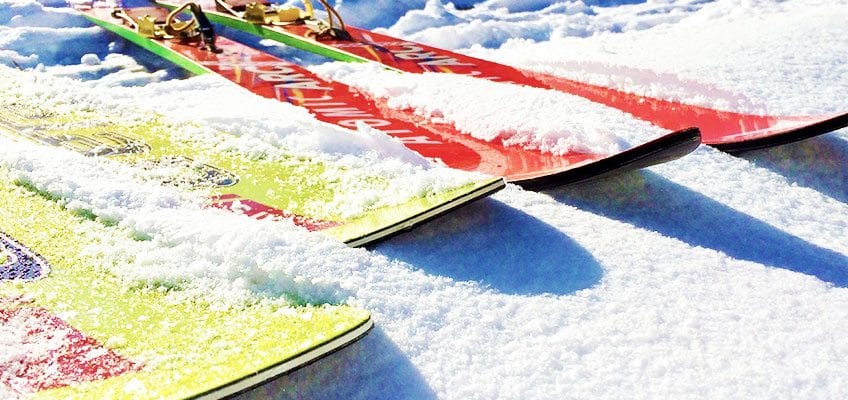How to Wax and Tune Your Skis

There are several professional ski tuning and waxing service providers out there, however, for those skiers who prefer learning the art and maintaining their skis themselves to save money as well as make personal adjustments to their individual needs, here are the key steps to become a pro yourself.
Tools you need
Tuning- Gloves, mill file, file guide, diamond Stone, paintbrush, gummy Stone, bungee cords and brake restraining device or thick rubber band.
Waxing– Heat proof gloves, brake restraining device or thick rubber band, an iron, p-tex candles, brass brush, base cleaner, wax, wax scraper and a pot scrubber or nylon brush.
Lesson 1 – Prepping and Edging
Step 1– Bring the skis indoors to room temperature after a day out skiing to bring it to a stable and warmer environment as it makes the waxing process a lot easier. You can begin by edging while you wait for the skis to warm up.
Step 2– Start the edging process by securing and clamping the skis sideways with the top facing you to a vise at a comfortable working height. In case you do not have vise, place two chairs facing each other with weights on the seats to make it stable. Now, lay the skis across on top of the seat backs and secure them with bungee cords.
Step 3– Keep the brakes out of the way by using brake retainers or a thick rubber band to pull the ski brakes out of the way from the edges.
Step 4– Take precaution to do the base edges, which is the edge between the base and the side of the ski. Sharpening the base is the same as sharpening the edge, however, take caution not to scratch the base as there is a higher risk. Begin by sharpening the base first before you do the edges.
Step 5– Check for burrs by running your fingers along the side edge of the skis which is between the upper surface and the side. If you notice rust along the edge or rough patches, file through those areas with a wet diamond stone or a gummy stone until smooth. Wear a glove to check the edges if they are already sharpened to avoid cuts.
Step 6– The next step is to adjust the skis. Reposition the skis, with the base horizontal and facing upward, ready for waxing.
Step 7– Start by cleaning off the old wax and dust. Rub the base and edges of the skis down with a paintbrush to remove the dust and debris. For stubborn old wax, use a base cleaner to make the job easier.
Lesson 2 – Waxing
Step 1– To repair gouges, you will need the p-tex candles. Gouges can result in exposing the metal layer underneath and you will need heat proof gloves to do the job as the candles burn very quickly and really hot.
Hold the burning candle over the gouge and drip the wax until the gouge is filled and take care not to spill the wax anywhere else. Allow the wax to cool off for an hour and after, scrape it flat using a wax scraper.
Types of wax
- Cold wax- Temperatures under 20ºF (-7º C)
- Medium wax – Temperature between 20 and 32ºF (-7º to 0ºC)
- Warm wax- Temperatures above 32ºF (0ºC).
Step 2– Use an iron with no holes to warm up the skis. Please note that the iron has to be solely for the purpose of warming up skis and not used for clothes. Set the temperature to a minimum and once it’s warm enough run it along the base once or twice to warm up the ski.
Step 3– The next step is to drip more wax onto the ski by pushing the wax in steady strokes against the iron throughout the length of the skis. Then iron the wax onto the skis until the wax has melted into a smooth surface.
Step 4– Leave the wax to cool for an hour or for best results, leave it overnight.
Lesson 3- Finishing
Step 1-The final step is to scrap excess wax off the skis. For a beginner, the safest option is to use a hard plastic ski scraper as metal scraper or wide razor blades can easily scratch the ski base.
Step 2– The way to do this is to hold the scraper with both hands by starting at the tip of the skis. Than hold the scraper and pull it firmly towards you and continue to do this until the unwanted flake has come off and the surface is smooth. Repeat the same movement with even pressure until you remove excess wax off every angle.
Step 3– After you finish, put a bit of texture back into the ski to improve performance by brushing along the base with a nylon brush to remove irregularities in the wax.


Leave a Reply
Want to join the discussion?Feel free to contribute!